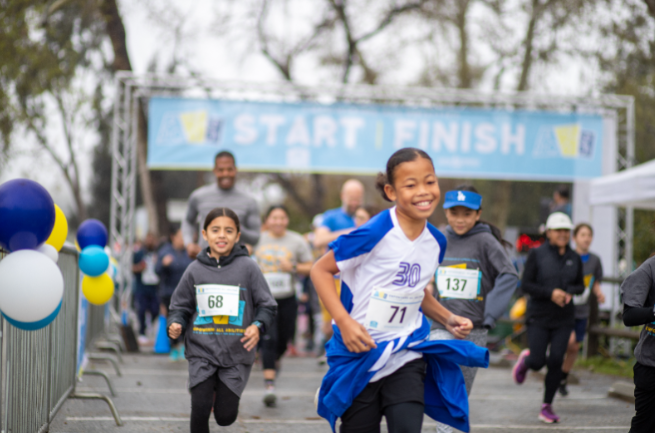Welcome to the Institute for the Redesign of Learning’s (IRL) beginner-friendly training guide for a Run/Walk event! Whether new to running, a novice runner, or more comfortable walking, this training guide will help you prepare for a 1K, 5K, or 10K event.
This guide will provide essential information and practical strategies to gradually build stamina and endurance, prevent injuries, keep your motivation levels high, and prepare for the big day. Let’s get started on your run/walk training!
Why a Run/Walk Training Guide?
Perhaps you want to improve your fitness, challenge yourself, or participate in a community event. Embarking on a run/walk can be an excellent way to achieve these goals. But, as with any new endeavor, having a proper training guide is crucial for success.
There are numerous benefits to preparing and following a training plan for a run/walk. First, it helps improve cardiovascular endurance and stamina. Regular training can strengthen your heart and lungs, enabling you to maintain physical activity for longer. Additionally, running or walking can help you burn calories, maintain a healthy weight, and reduce the risk of chronic diseases such as heart disease, diabetes, and certain cancers.
The right training is essential to avoid injuries and achieve your desired results. It’s important to consider your current fitness level, existing health conditions, and how much time you can devote to training. A well-thought-out training will gradually increase your distance and intensity over time, allowing your body to adapt and reducing the risk of pushing yourself too hard.
Setting achievable goals is another important aspect of successful run/walk training. Whether you aim to complete your first 1K, 5K, or 10K or improve your record, having specific, measurable, achievable, relevant, and time-bound (SMART) goals can provide you with motivation and direction. Setting achievable goals allows you to monitor your progress and celebrate milestones. Examples of SMART goals for a run/walk:
- Specific:
- Example: “I will complete a 5K run-walk.”
- Measurable:
- Example: “I will track my progress using a fitness app and aim to improve my pace by 1 minute per week.”
- Achievable:
- Example: “I will start with a 30-minute run-walk session three times a week and gradually increase the duration as my fitness improves.”
- Relevant:
- Example: “I will incorporate a combination of running and walking to improve cardiovascular fitness, stamina, and overall health.”
- Time-bound:
- Example: “I will achieve my goal of completing a 5K run-walk in 8 weeks, with weekly progress check-ins.”
Remember to tailor these examples to your personal fitness level and preferences. Adjust the duration, frequency, or specific targets based on what feels challenging yet realistic for you. Also, consult a healthcare professional before starting any new exercise routine, especially if you have pre-existing health conditions.
Building Stamina and Endurance
Building stamina and endurance is crucial for completing a run or walk. Whether you are a beginner or looking to improve your performance, specific training techniques can help you reach your goals. Here are three key strategies to enhance your stamina and endurance:
Understanding the Importance of Warm-up and Cool-down: Before starting any training session, it’s essential to warm up your muscles and prepare your body for the exercise ahead. A dynamic warm-up routine featuring exercises like spot jogging, lunges, and arm circles helps increase blood flow, loosens up your muscles, and reduces the risk of injury. Similarly, cooling down after your run or walk with gentle stretching exercises aids your body’s recovery and prevents post-workout muscle stiffness.
Implementing Interval Training: Interval training involves alternating between high-intensity effort and active recovery periods. This type of training can significantly improve your cardiovascular fitness, endurance, and overall performance. You might, for example, alternate between running or walking at a faster pace for 1-2 minutes and then slowing down to a comfortable pace for 2-3 minutes. As your fitness improves, you can gradually increase the duration and intensity of your intervals.
Adding Hills and Speed Work: Incorporating hill workouts and speed work into your training guide can challenge your body and build strength and stamina. Running or walking uphill engages different muscles and increases cardiovascular workload, improving endurance. Including short bursts of speed work, such as sprinting for 30 seconds followed by a recovery period, helps increase your overall speed and stamina. In case you’re wondering, the 5K and 1K routes of the Empowering All Abilities Run/Walk do not include hills.
By incorporating these strategies into your training guide, you can gradually build stamina and endurance for a run/walk. Remember to listen to your body, take rest days, and progressively increase the intensity and duration of your workouts. With consistency and determination, you’ll be well-prepared to tackle your run/walk goal.
Avoiding Injuries and Keeping Motivated
When preparing for a 1K, 5K, or 10K run or walk, it’s crucial to prioritize injury prevention and maintain motivation throughout the process. Here are some key strategies to help you stay on track:
- Effective Stretching Techniques: Before and after each training session, take the time to stretch your muscles properly. Dynamic stretching before your workout helps warm up your muscles and increase flexibility, while static stretching after your workout aids in muscle recovery and prevents tightness.
- Strength Training for Runners and Walkers: Including strength training exercises in your routine can be highly beneficial. Focus on exercises that target your lower body muscles, such as squats, lunges, and calf raises. Strengthening these muscles not only improves your performance but also helps prevent injuries.
- Staying Motivated throughout Training: Keeping motivated can be challenging, but with the right approach, you can stay focused on your goals. Set realistic and achievable goals, break your training guide into smaller milestones, and reward yourself when you reach them. Additionally, find a training partner or join a local running or walking group to stay motivated and accountable.
Incorporating these strategies into your run or walk training guide will enhance your performance, reduce the risk of injuries, and motivate you throughout your journey. Remember to listen to your body, rest when needed, and enjoy the process of improving your fitness and reaching your goals.
Preparing for Race Day
Preparation for race day is crucial to ensure optimal performance and achieve your goals. This section will discuss important factors such as nutrition and hydration, race day gear and equipment, and pacing strategies for runners and walkers.
Nutrition and Hydration for Optimal Performance:
Proper nutrition and hydration play a crucial role in your race day performance. Fueling your body with the right nutrients is essential to sustain energy levels throughout the event. Before the race, eat a balanced meal with carbohydrates for energy, lean proteins for muscle repair, and healthy fats for sustained endurance. Stay hydrated by drinking plenty of water in the days leading up to the race and during the event.
Race Day Gear and Equipment:
Having the right gear and equipment can significantly improve your comfort and performance; however, you don’t have to spend much money. Choose appropriate running or walking shoes that provide adequate support and cushioning. Wear moisture-wicking clothing to keep you dry and comfortable. Use a GPS watch or smartphone app to track your distance and pace during the race.
Pacing Strategies for Runners and Walkers:
Pacing is a tactic to avoid fatigue and achieve your desired race time. For runners, start with a slightly slower pace than your goal speed and gradually increase as the race progresses. Walkers should establish a steady and consistent pace to maintain energy levels. Be sure to listen to your body and adjust your pace accordingly to avoid exhaustion.
These race-day preparation strategies can optimize your performance and enjoy a successful run or walk. Remember to train consistently, stay focused, and, most importantly, enjoy the experience. Good luck!
If you haven’t already, this is your sign to register for the Empowering All Abilities Run/Walk. Use code SUPPORT for 10% off registration for the 5K and 10K events.
Disclaimer: Before you start this run/walk training, consult your doctor.
This guide provides general information, not medical advice. It’s essential to know your limits and health status. If you have health concerns, get a doctor’s clearance first.
There are risks involved in any exercise program. The creators are not responsible for injuries or health issues. Stop if you feel pain and seek professional advice.
This guide might only be suitable for some. Adjust the exercises to your fitness level. By using this guide, you agree to these terms. If you disagree, do not proceed with the training.

